How Kate Became A Princess
by Emma Garman
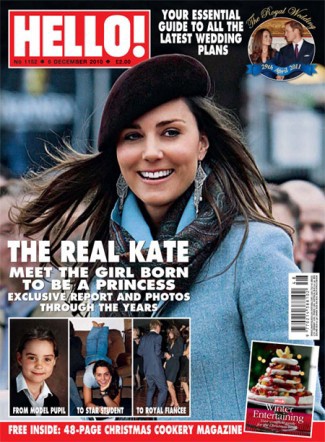
A series dedicated to explaining Britain’s manufactured celebrities to an American audience.
Heartbreaking confession time: I was born with a rare condition, of unknown etiology, that causes my skin to break out in hives whenever I see grown women dressed as fairy princesses and throwing around phrases like “my special day” and “beach-themed centerpiece.” Nevertheless, in my dedication to delivering scoops no matter how intrepid the investigation — in this instance, perusing TLC message boards and IMing with a make-up artist named Flavio — I’ve obtained cast-iron confirmation that no bride is permitted to grace any wedding show (“Say Yes To The Dress,” “Bridezilla” et al) without contractually committing to intone, on command and with the utmost dreamy, moist-eyed reverence, “I feel like a PRINCESS!” And thus the J-Lo sponsored, blood diamond-supporting Wedding Industrial Complex flourishes in the face of dire threats, namely the global economic crisis and that adorable little girl whose proto-feminist rant against the gendered marketing of princess toys went mad viral.
Yet the myth that every American female longs to be a princess cannot survive by reality TV alone. The occasional British Royal Wedding, like last year’s espousal of Prince Willy and Commoner Kate, also feeds the fantasy, especially since a Windsor Wedding inevitably means a totalitarian state-style media blanketing of 24/7 speculation about who will design the dress, with the odd discussion of royal beheadings thrown in to lighten the mood. And the very ordinariness of Kate, who happens to be the first regular pleb to marry a future British King since 1660, constitutes an even greater boost to the WIC, because if one humble civilian can be elevated from her lowly station to princessdom, then it’s only fair that everyone else should get a chance, if only for just one day. But how did plain old Catherine Elizabeth Middleton get to be Her Royal Highness Princess William, Duchess of Cambridge, Countess of Strathearn, Baroness Carrickfergus? Aspirants to a life of crown wearing, of waving at the little people, of conducting stultifying conversations with racist nonagenarian in-laws, of having one’s embarrassing indiscretions taped by the security services: listen and learn.
Our fairytale must begin by paying tribute to the woman whose lauded Mama Rose-level ambition saved Prince William from his expected, ghastly fate: marrying either a hearty English aristo named Moffy or a minor European royal with whom he shares at least one mutant gene. Kate’s mother Carole Middleton (née Goldsmith), a self-made businesswoman and native Londoner, is said to have inherited her mighty drive from her own mother. A carpenter’s daughter born in rural County Durham, the late Dorothy Goldsmith was a formidable figure whose airs and graces earned her the nickname Lady Dorothy. “She wanted to be the top brick in the chimney,” reminisces a relative. “You got the feeling that she thought she was too good for the rest of us.”
So when, as a young woman, Carole began working as a flight attendant for British Airways, her mother was by all accounts delighted by the rich husband-bagging potential the job promised. The fellow BA employee with whom Carole did strike up a romance, a dispatcher named Michael Middleton, wasn’t necessarily rolling in it but he was fairly well to do: his paternal grandmother came from one of Leeds’ richest merchant families and he could trace his lineage back to seventeenth century Parliamentarian Sir Thomas Fairfax — as could William’s mother Diana, making William and Kate fifteenth cousins.
Of course Diana, God rest her insane narcissistic soul, was actual nobility, the daughter of a Viscount and an Hon. Still, given the unrelenting PR disaster that was Diana and Charles’ marriage, you might think that William’s choice of an ordinary, sensible girl would have gone down well in royal circles. But that would be to massively underestimate the ancient British relish for policing class divisions: when Kate was established as William’s serious girlfriend, whispers abounded — i.e. were assiduously uncovered by the press — that Carole Middleton, whose forebears were coal miners and laborers and who herself ran a company selling party favors, was far too common to be the mother of a future Queen.
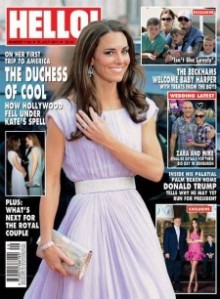
It was Non-U enough that Carole was once a “trolley dolly,” hence the charming tendency of William’s hooray friends, who mostly wouldn’t know an honest day’s work if it leapt out of their Crack Baby cocktails and punched their chinless faces, to mutter “doors to manual” when Kate appeared. But possibly the most damning evidence of Carole’s frightful lack of breeding emerged when she was first introduced to the Queen, only to allegedly utter the phrase — and there’s just no way to sugarcoat it, so do forgive me — “Pleased to meet you.” Despite the undisputed gravity of this faux pas, opinion was troublingly divided as to the appropriate greeting: the Telegraph, for example, reckoned “How do you do” was the “accepted” form of address, while other scholars of snobbery argued for a simple “Hello ma’am.” (But far be from me to intensify anxiety about what to say when meeting Liz: please be advised that you can’t go wrong by sidestepping the whole debate and growling, Ray Winstone-ishly, “Aw-ight, Yer Maj?”)
Monumental linguistic blunders, shameful career history, and let’s not even weary ourselves with the whole chewing gum in public fiasco — suffice it to say, during Kate and William’s seven-year courtship, Carole was cast in the role of major liability to her daughter’s Royal Wedding dreams, a 21st-century Mrs. Bennet to Kate’s blameless Elizabeth. “The only thing counting against Kate is her mother,” opined a Daily Express-quoted “royal observer” — a credential that presumably encompasses senior Palace courtiers and keen readers of Hello magazine — in 2009. “The father is terrific. The Queen approves of him and he is liked; the mother has big question marks. She is very pushy, rather twee and incredibly middle class.”
Carole’s legendary pushiness gets the credit/blame for bringing the young couple together in the first place. When 18-year-old Kate — who’d harbored a crush on William for years, say her boarding-school friends — was choosing a college, Carole was supposedly of the mind that there was only one option: St. Andrews in Scotland, where per an official announcement William would be attending. According to biographer Christopher Andersen, it was during her gap year between high school and university that Kate “finally caved in to her mother’s incessant demands” and agreed to enroll at St. Andrews. Carole even suggested, claims Andersen, that “there would be ways to get even closer to the prince” via housing choices.
(When Kate’s younger sister Pippa went to Edinburgh University, she made mama proud by getting a flat with “two such nice boys” — George Percy, an earl who’s the eldest son of the Duke of Northumberland, and Lord Ted Innes-Ker, the second son of the Duke of Roxburghe. Eventually, Kate and Pippa would become known as the Wisteria Sisters, because they’re “decorative, terribly fragrant, and have a ferocious ability to climb.” Speaking of which, rumor has it that on New Year’s Eve, Pippa decided it was time things turned romantic with George and his $400M fortune.)
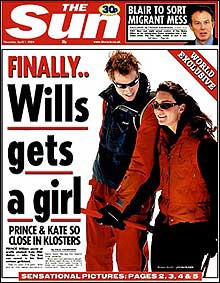
Whether by deliberate maneuvering or mere coincidence, Kate and William arrived at St. Andrews and moved into the same halls of residence (the school has eleven), quickly becoming good friends and eventually lovers. A Royal decree had forced the press to leave William alone for his college years, so the couple managed to enjoy a relatively low-key relationship, even moving in together as “housemates” with two friends. But in 2004, when they were seen kissing on a skiing vacation in Switzerland, those die-hard sentimentalists at the Sun decided that telling the world about the young prince’s first love trumped a silly old embargo, and ran a touching front-page headline: “FINALLY…WILLS GETS A GIRL.”
Funnily enough, the media feeding frenzy that ensued didn’t exactly ease the path of true love, and in 2007, a couple of years after he and Kate graduated from St. Andrews, William broke things off. Reportedly, the Royal Family had conveyed that in light of the tabloids’ “Waity Katie” label, as well as the Palace’s powerlessness to make any official provision for Kate’s protection from the voracious press unless she and William were engaged, he had to make a decision one way or another.
Kate, never one to sit around and mope, embarked on an impressive campaign involving getting papped with shiny hair and a beaming smile, dirty dancing at nightclubs with other eligible toffs, and generally giving a master class on How to Show Him What a Huge Mistake He’s Made. The clincher was Kate’s new membership of an all-girl rowing crew, The Sisterhood, run by diplomat’s daughter and high-class orgy organizer Emma Sayle. A tanned, serene Kate was photographed on tiller duty dressed in a tight white tank top, wind streaming through her hair, sunlight glinting on her toned arms as she steered the boat along the Thames, and on that ubiquitously published image did the bloodline of the monarchy pivot. Which is to say: it worked like a charm.
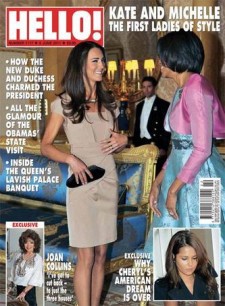
Alas, we must reconcile ourselves to the likelihood that the spirited-bordering-on-scandalizing side of Kate witnessed during those brief weeks may never enliven the tabloids again. What makes her so very suitable as a royal bride — hopelessly middle-class mother notwithstanding — is also what makes her supremely dull as a public figure: her faultlessly good behavior. As you can well imagine, biographers and journalists have scoured all four corners of the globe in search of something — anything! — juicy from her past, and come up empty handed. She was a well-liked and sporty pupil at her expensive co-ed boarding school, where she never got in any trouble and certainly didn’t lose her virginity. In Italy during her gap year, she indulged in the odd glass of wine, but that was where she drew the line. “She was never interested in getting really drunk or letting herself lose control,” recalls a friend. “While others were doing drugs around her, she wouldn’t be judgmental — in fact she was quite interested in what they did to you. It was simply that she did not want to try them. I never saw her smoke either.” And needless to say, she’s awfully nice to the help. “She is a delightful girl,” one of William’s bodyguards told Christopher Andersen. “Very down-to-earth, very considerate. She says hello and treats you like a person, never acting like you’re not there.”
Oh, for the days when Diana was feuding with Elton John and dabbling in the occult, or Fergie was getting her toes sucked by her financial advisor. The only entertaining controversy in Kate’s background is her Uncle Gary, a thrice-married property developer who made his fortune in computers. Carole’s younger brother by ten years, Gary Goldsmith owns a notorious party pad on Ibiza, La Maison de Bang Bang, where Kate and William have enjoyed hospitality and where, in 2009, the News of the World dispatched two reporters posing as businessmen. Blithely unaware that he was being recorded, the extroverted forty-something — whose tattoos include such admirably brazen shibboleths as “Nouveau Riche” and “Spend And God Will Send” — chopped out lines of coke, generously offered a personal referral to his pimp (“there are loads of Brazilian girls here”) and bragged about joining the royal family, even though an engagement was yet to be announced.
Regrettably but unsurprisingly, we don’t often hear about Uncle Gary these days, but perhaps it’s not too much to hope that he’s been taken under the wing of Prince Andrew. Gary and Air Miles Andy are bound to have loads in common, and I like to fondly imagine them hanging out at naked pool parties with Andy’s bestie Jeffrey Epstein, chatting about illegal sexual procurement and swapping stock tips.
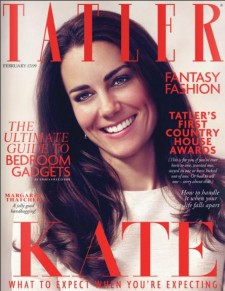
Kate’s preternatural decorum and reliability was no doubt a central consideration in calculating the betting odds on when and if the royal couple will divorce, with most bookmakers heartwarmingly confident that they’ll make it to their 10th anniversary, should you fancy a wager. Meanwhile, the odds offered on Kate becoming a mother in 2012 are fluctuating depending on various seismographically-weighted factors: has she recently been photographed with a hand vaguely over her stomach? Spotted drinking a non-alcoholic beverage? Did the precise curvation of her evening gown’s waist seam hint at anything other than size-zero slenderness? Or has a doctor of uncertain repute who does not treat the Duchess diagnosed her weight as below the optimum for fertility? And without wishing to get too confoundingly sciencey, has a “body language expert” pronounced that the precise gait of Kate’s stride might possibly indicate a bout of nausea? Finally, and arguably most vitally, what say the visions of Diana’s favorite psychics?
Obviously, whether to have a baby, even a royal heir whose lifestyle choices from cell-splitting stage will be internationally newsworthy, is a very personal decision on which your upstanding columnist wouldn’t dream of passing comment, unlike legions of her more uncouth colleagues. That said, Kate might like to bear in mind that she’s been placed in the deeply ignominious position of sharing second place with Jennifer Lopez and Demi Moore as 2011’s most frequent cover star of In Touch Weekly, with the “stars” of MTV’s “Teen Mom” at number one — a situation that none of us, least of Kate herself, will wish to see repeated.
The arrival of a blue-blooded sproglet or not, our Duchess can at least comfort herself with the knowledge that “Kate” is predicted to be this year’s most used word in the media (last year’s was “occupy”), thanks to her role as ambassador of the Olympic Games and her ever-burgeoning status as a global style icon. Retail analysts believe that Kate has boosted the UK fashion industry by £1BN as droves of women buy everything she’s seen in: the Burberry trench coat she wore on a visit to Northern Ireland sold out worldwide in 12 hours despite its $1000 price tag, while the beige body-con dress she wore to meet the Obamas in May ended up selling on eBay for more than quadruple its original price, and has now been knocked off by Banana Republic. (The Kate Sheath can be yours for just $130, hideous sapphire and diamond ring that’s probably cursed not included.)
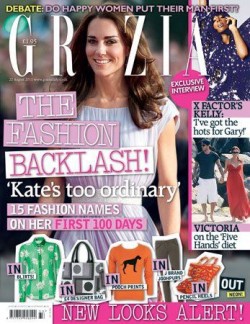
Of all the stresses and responsibilities inherent in her royal role — the foreign diplomacy, the patronage of carefully-selected charities, the intense pursuit of the paparazzi, the traipsing around in wellington boots shooting innocent creatures for sport — it is the importance placed on Kate’s fashion choices that looms largest. Last week, when she attended an event at the National Portrait Gallery wearing an outfit by Jesire, a defunct fashion label, journalists and style bloggers went into convulsions. “We’ve googled, we’ve eBayed, we’ve phoned former PRs and ex-stockists of the brand, but this particular piece is turning out to be a total and utter mystery,” wrote Grazia’s Hannah Almassi. “Where and when did the Duchess get it? How much did it cost? Has it been sitting in her wardrobe for yonks or did she recently buy it from her favourite second-hand store?”
Pressing questions indeed, but even if they’re never satisfactorily answered, Kate’s public will somehow have to pick up the pieces of their lives and carry on. Knowing Kate, she’ll be filled with remorse for not considering the emotional and financial ramifications of wearing a garment not immediately available for purchase, and firmly resolved never to commit such an error again. The same goes for wearing the same dress twice, which she did last summer to widespread consternation, prompting noted constitutional pundit Kelly Osbourne to tear her off a strip, and rightly so. For let us be quite clear: Kate is not simply getting dressed, she is shaping history. Along with at some point popping out an heir and a spare — maybe when Alice Temperley has some new maternity dresses out? — being mercilessly judged on every single sartorial detail is her duty to country and commonwealth, and may God grant her the strength to carry it out with dignity.
Previously: Ryan Giggs, Amy Childs, Jordan and Boris Johnson.
Emma Garman no longer lives in her native UK, but she still watches lots of its TV. She’s also on Twitter.
